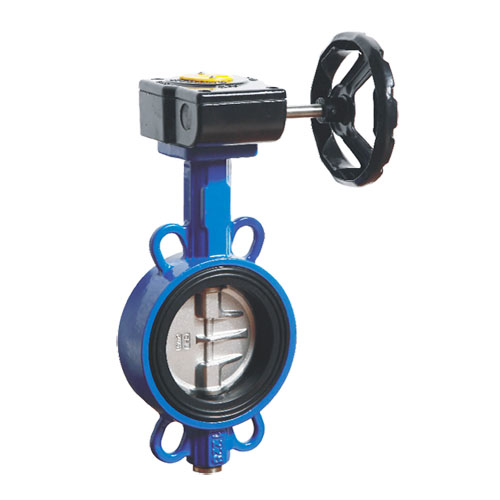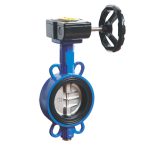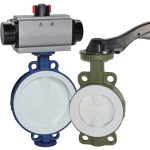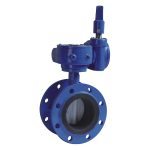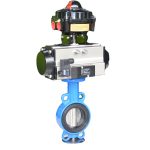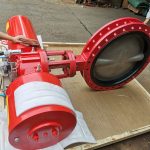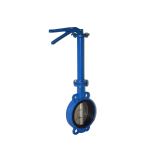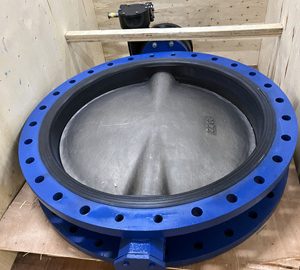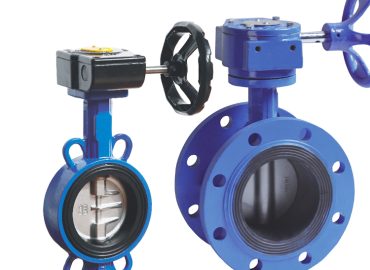In industrial settings, selecting the right valve is crucial for ensuring optimal performance, efficiency, and safety of the process. Gate valves and butterfly valves stand out among the most common types of valves used in industrial applications. Both valve types perform crucial functions such as regulating fluid flow and preventing backflow. However, when it comes to selecting the appropriate valve, choosing between a gate valve and a butterfly valve can be challenging. In this blog post, we will explore the advantages of using a gate valve vs a butterfly valve, discuss the differences between the two valve types, and help industrial operators choose the right type of valve for their specific applications.
Introduction
In industrial applications, both gate valves and wafer butterfly valves offer their own unique advantages. Gate valves provide better protection from high-pressure environments and have better corrosion resistance, making them more suitable for certain applications. They also have more efficient fluid flow operations and ensure tight shut-off when needed. On the other hand, butterfly valves are better for applications where there are space restrictions and are generally lower in cost. They are also easier and more efficient to automate. Depending on the specific context of their use, one may be more advantageous than the other. In the following paragraphs, we will take a closer look at each valve type, the differences between them, and scenarios where one may be more favorable than the other.
Explanation of the differences between gate vs butterfly valve
Gate valves and butterfly valves differ in both structure and function. A gate valve operates by opening and closing a gate that is situated within the valve, allowing or preventing the flow of fluid. They are either fully open or fully closed, in line with their on-off functionality. Butterfly valves, on the other hand, operate by rotating a disc or wafer in the valve to control flow. They are designed to modulate flow, oftentimes from fully open to fully closed, and frequently utilize quarter turn actuation methods. Gate valves require a linear movement to open and close, while butterfly valves operate through a quarter turn rotation. These design differences make each valve better suited for specific environments.
Highlights on the importance of selecting the appropriate valve for specific industrial applications
Selecting the appropriate valve for specific industrial applications is crucial for optimal operational efficiency and safety. Each valve type boasts its own set of benefits, drawbacks, and specific use cases. The wrong valve selection may lead to issues like decreased system performance, increased maintenance costs, and even situations that put the safety of workers at risk. For example, selecting an oversized gate valve for a water application with rapid cycles may lead to the quick wearing of the valve components or the need for frequent maintenance. Similarly, selecting a butterfly valve for handling corrosive chemicals may lead to erosion and wear of the valve, eventually causing leaks. Therefore, taking care to select the appropriate valve type for specific applications helps to prevent these concerns and ensure long-term functionality and safety.
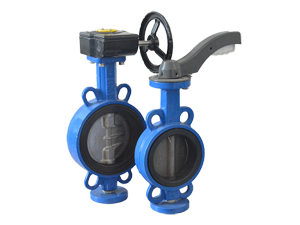
Advantages of Gate Valves
Gate valves offer a range of advantages in industrial applications. One significant advantage of gate valves is the tight seal they provide when closed. By blocking the flow entirely, gate valves prevent any possibility of backflow, which can be especially crucial in applications that deal with hazardous or expensive materials. Additionally, gate valves can handle high-pressure environments with ease, making them ideal for applications like oil and gas extraction and refining. Gate valves also have a straightforward design, which makes them easy to maintain and repair. Finally, gate valves can be used in a wide range of materials, including stainless steel, brass, and cast iron, further adding to their versatility and suitability for industrial settings.
Tight shutoff and leakage prevention
One of the essential characteristics of gate valves is their ability to provide a tight seal when closed. This feature is critical in industrial processes where materials or fluids must remain contained in designated areas. A gate valve’s design ensures that it can provide a complete shut-off, blocking the passage of fluid entirely. This tight shut-off creates a barrier and prevents any backflow that could cause damage or contamination. Furthermore, the lack of internal pockets in gate valves reduces the likelihood of debris accumulation, which can also lead to leakage or contamination. With such effective and reliable shut-off features, gate valves are a smart choice for industrial applications that require tight control over flow, ensuring that materials remain within their intended path of transport.
Throttling capabilities
While gate valves are ideal for providing tight shutoff, when it comes to the regulation of flow velocity over time, they are less effective. However, butterfly valves are ideal for this purpose. Butterfly valves have the ability to regulate flow or throttle based on the position of the disc in the valve, which serves as the valve’s controlling mechanism. When partially open, a butterfly valve turns the disc inside allowing for targeted flow regulation and a slower rate of fluid intake, which then impacts the flow’s velocity. As a result, butterfly valves are often used for applications that require precise adjustment of flow rates, such as the regulation of pipelines for crude oil or chemical transport. Throttling capabilities, when combined with precise closing and opening operation, offer the necessary degree of functionality that is required in industries like oil and gas, chemical processing, and natural gas pipelines.
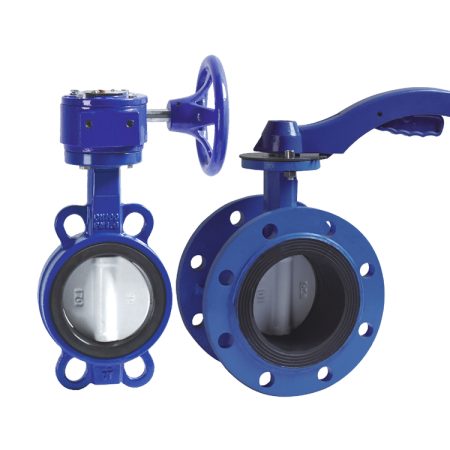
Suitable for high-pressure applications
Gate valves are ideal for high-pressure applications, as they are designed to withstand higher pressures than their butterfly valve counterparts. Gate valves can efficiently handle working pressures up to 1500 PSI or more, making them suitable for use in critical applications such as pipelines, oil refineries, and power plants. Due to their sturdiness and durability, gate valves can maintain tight shut-off, even under high-pressure conditions, preventing equipment damage, safety hazards, or environmental concerns that could occur with other less robust valve types. The ability to regulate the flow of fluids under high-pressure conditions, coupled with their durable design, makes gate valves one of the most reliable and preferred valve types in industrial settings.
Durable and long-lasting
Gate valves are well-known for their durability and longevity in industrial settings. They are designed to withstand harsh conditions, heavy usage, and continuous operation, which is critical in environments where downtime or repairs can be extremely costly. The materials used in making gate valves, such as stainless steel, brass, and cast iron, are also inherently durable and resistant to corrosion from harsh chemicals and weather conditions. The low-maintenance design of gate valves, coupled with their sturdy construction, makes them an affordable and long-lasting option for industrial operators. They require minimal upkeep, reducing the need for frequent replacement and lowering overall operational costs. Whether used in water treatment, oil and gas, or chemical processing, gate valves can provide years of reliable service in even the harshest industrial environments.
Easy to manufacture in large sizes
Gate valves are also easy to manufacture in large sizes, making them ideal for applications that require a larger diameter. The valve’s two plate-like structures and stem design make it easier to enlarge while still maintaining stability and integrity. This is in contrast to butterfly valves, which can be more challenging to build in larger sizes due to their disc or wafer design. As a result, gate valves have been used in large industries that require bigger valve sizes, such as oil refineries, chemical plants, and power plants. The possibility of more diverse valve sizes and applications that come with the ability to produce large gate valves makes them valuable assets within industrial settings.
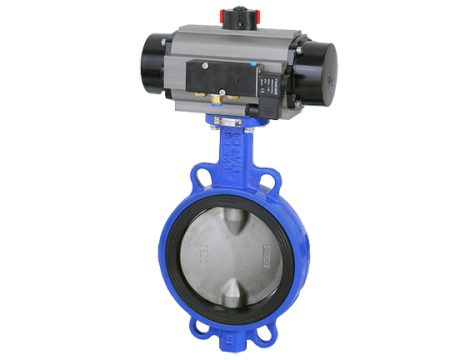
Advantages of Butterfly Valves
Butterfly valves are used in various industries due to their unique characteristics and advantages. One significant advantage of butterfly valves is their lower cost compared to other valve types, including gate valves. They are also compact and lightweight, making them well-suited for applications with limited space requirements. Another advantage of butterfly valves is their ease of use and quick installation. They are designed to operate with a simple 90-degree turn and do not require extensive training or expertise to manage. Additionally, butterfly valves are often used in industries that require automation, as they are easy to automate and integrate into control systems. Butterfly valves’ wide range of materials can be utilized, including plastic and rubber, which is beneficial in industries that handle corrosive or aggressive fluids or gases. Overall, the advantages and versatility of butterfly valves make them a popular choice within industrial settings.
Controllable flow and minimization of pressure drop
Another advantage of butterfly valves is their controllable flow and the ability to minimize pressure drop. Butterfly valves can be used to regulate the flow of fluids through their control mechanism, the disc, which can function as a regulator for precise control of flow rates. The ability to throttle fluid flow enables users to control variables such as pressure and temperature, allowing for optimization of system performance. Additionally, butterfly valves minimize pressure drops experienced when fluids pass through them, which reduces energy consumption and increases system efficiency. As a result, butterfly valves are frequently used in applications that require pressure regulation, such as HVAC systems, waste handling, and water treatment plants. The ability to regulate and manage fluid flow is a vital aspect for maintaining optimal system performance, and pneumatic butterfly valve offer an effective way to control such variables.
Suitable for low-pressure applications
Butterfly valves are ideal for low-pressure applications, as they are designed to handle lower working pressures compared to their gate valve counterparts. Thanks to their design, butterfly valves are highly sensitive to changes in pressure, which makes them perfect for applications that require precise throttling and flow control, such as water distribution and wastewater treatment. They are capable of handling pressures of up to 200 PSI, which is lower than what a gate valve can handle, but still sufficient for many industrial applications. Butterfly valves are also lighter and more compact, which makes them easier to install and maintain. Furthermore, the disc design of a butterfly valve minimizes pressure drops and is effective in regulating flow rates. With their range of capabilities and perfectly suited for low-pressure applications, butterfly valves are a wise choice for industries that require efficient and reliable low-pressure flow control.
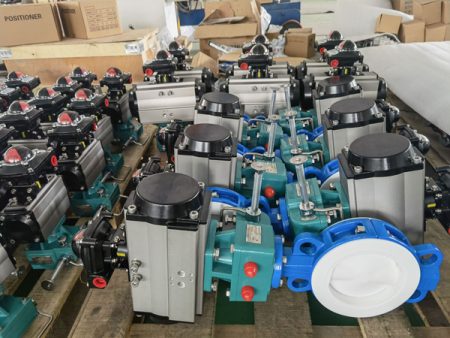
Lightweight and less costly
Butterfly valve are well-known for their lightweight design and cost-effectiveness compared to other valve types. Thanks to their simple construction and fewer components, butterfly valves are much lighter than gate valves, making them ideal for applications when space and weight are at a premium. As butterfly valves require fewer materials to manufacture and are often smaller in size, they are generally less costly than gate valves, particularly in smaller sizes, which makes them a popular choice for industrial operators looking to get the most out of their investment. Butterfly valves also require less maintenance due to their straightforward design, making them a more affordable and practical option over the long-term. The low cost of butterfly valves, combined with their lightweight design and ease of maintenance, makes them an attractive choice for various industries, including oil and gas, wastewater treatment, and HVAC.
Simple to maintain, inspect and repair
Maintaining and repairing butterfly valves is relatively simple when compared to other types of valves. Butterfly valves have few components, making them easy to disassemble, inspect, and repair. The disc and stem are the only two significant parts of a butterfly valve, making replacement of parts much more straightforward than with gate valves. Butterfly valves’ compact design allows for easy access to all its parts, making it easier to inspect for any damage, wear or tear that may occur over time. Additionally, butterfly valves have less internal cavities, eliminating the potential for debris buildup that can cause operational issues. Overall, the simple, straightforward design of butterfly valves makes them an ideal choice for industries that require easy maintenance and repair, resulting in lower overall costs over the valve’s lifespan.
Ideal for tight space installations
Butterfly valves are well-suited for installations in tight spaces due to their compact design. As they require less space than gate valves, it’s easier to fit them into industrial systems or equipment with limited space requirements. Butterfly valves have a flat profile, which also makes them ideal for applications where space is at a premium. Additionally, the simple and lightweight design of butterfly valves makes them easy to maneuver, align, and install, which is essential when working in tight spaces. Industries where space is limited may include HVAC systems, industrial cooling systems, and others. The ability of butterfly valves to be installed in tight spaces allows for greater flexibility in system layout and design, providing more efficient and effective processes overall.
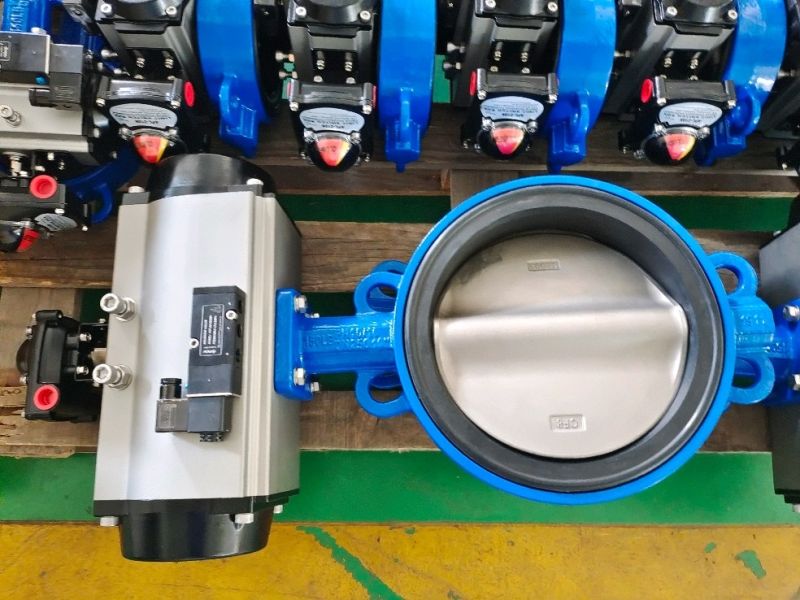
Application-based comparisons of Gate vs Butterfly Valve
When it comes to comparing gate and butterfly valves, the right choice depends on the specific application requirements. Generally, gate valves are ideal for applications that require high-pressure handling and tight shut-off, making them suitable for oil and gas pipelines, power plants, and chemical processing. On the other hand, butterfly valves are more cost-effective and lightweight, making them the preferred choice for low-pressure applications such as HVAC systems, water distribution, and wastewater treatment. Butterfly valves are also suitable for installations with limited space, where their compact design and ease of installation make them the preferred choice. Applications that require frequent operation and easy maintenance would benefit more from butterfly valves’ simple design, which is easy to inspect, repair, and maintain. In summary, the valve type to be used in an application should be based on the specific requirements, including pressure, flow control, space limitations, maintenance, and repair.
Industries that utilize Gate Valves
Gate valves are widely used in various industries that require high-pressure handling and tight shut-off. One major industry is the oil and gas industry, where gate valves are used in pipelines, refineries, and offshore drilling, among others. The power generation industry also utilizes gate valves in power plants, where they control the flow of steam or water in boilers and turbines. Chemical and petrochemical processing industries use gate valves in their plant facilities to regulate the flow of chemicals and processing materials. Additionally, water treatment plants, sewage treatment plants, and mining industries utilize gate valves in their equipment for the precise control of fluids, in addition to preventing leakage and spills. Overall, the robust and durable design of gate valves makes them an essential component in the industries that require high-pressure handling and strict shut-off applications.
Industries that utilize Butterfly Valves
Butterfly valves are pervasive in various industries because of their wide-ranging advantages and versatility. For example, the food and beverage industry frequently uses butterfly valves in metering and packaging operations since it is easy to sanitize their disc design. In wastewater treatment processes, both municipal and industrial plants rely on butterfly valves to regulate fluids in low-pressure applications. The chemical and pharmaceutical industries also utilize butterfly valves since their disc design can be coated with various materials to prevent corrosion. The oil and gas industry often employs butterfly valves in low-pressure systems, such as water injection wells and saltwater disposal systems, for effective flow control. Finally, the power generation industry uses butterfly valves to regulate cooling water flow to their turbine condensers, among other applications. The wide range of uses for butterfly valves across various industries underscores their broad applicability and adaptability to various situations.
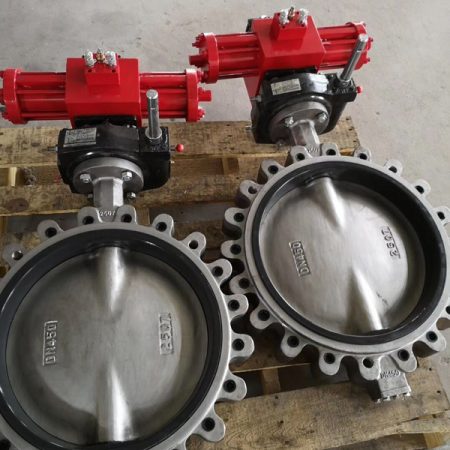
Choosing between Gate and Butterfly Valve
Before choosing between gate and butterfly valves, it is essential to consider the specific requirements of the industry and application. Firstly, determine if the application requires high-pressure handling or low-pressure operations. Gate valves are ideal for high-pressure applications, while butterfly valves are preferable for low-pressure applications. Secondly, the required tight shut-off and precision in controlling the flow rate must be considered. Gate valves offer better shut-off capabilities, while butterfly valves are better for flow control. Thirdly, space limitations within an operation must be considered. Butterfly valves are typically more compact, making them ideal for tight spaces. Finally, maintenance and repair requirements should be considered, with butterfly valves requiring less maintenance due to their simpler design. By taking these factors into account, an informed decision between gate and butterfly valves can be made, ensuring the best performance and value for the specific application.
Questions to consider when selecting a valve
When selecting a valve, there are several questions to consider to ensure the most effective and efficient choice. Firstly, it is vital to determine the specific application requirements, including the fluid type, pressure, and temperature. Secondly, the flow rate required, and how the valve will need to control it, should be evaluated to ensure optimal performance. Thirdly, it is important to consider the overall system design and layout, including available space and compatibility with existing equipment. Fourthly, maintenance, repair, and replacement requirements should be considered, as they can impact the long-term cost-effectiveness of the valve. Finally, industry and regulatory standards should be taken into account, to ensure compliance and safety. By carefully considering these factors, the most suitable valve can be selected to meet the specific needs of the application, ensuring optimal performance, safety, and value.
Summary of the above outlining a recommended procedure for choosing the right valve
Selecting the right valve involves a series of considerations to achieve the most efficient and appropriate choice for the specific application. Firstly, determining application requirements, including fluid type, pressure, and temperature. Secondly, identifying the necessary flow rate and how the valve will need to control it to optimize performance. Thirdly, assessing factors such as system design, available space, and equipment compatibility, followed by careful consideration of maintenance, repair, and replacement needs. Lastly, be sure to account for industry and regulatory standards to ensure safety and compliance. By considering these factors, a recommended procedure for choosing the right valve includes thoroughly evaluating the application’s needs, researching and understanding the features and capabilities of potential valve options, and selecting the option that ranks highest in meeting the specific requirements.
Conclusion
In conclusion, both gate and butterfly valves offer specific advantages that make them preferable for different applications. While gate valves excel at high-pressure handling and tight shut-off, butterfly valves offer greater flexibility, lower cost, and simpler maintenance and repair. Understanding the specific application requirements is crucial when deciding between gate vs butterfly valves. The choice should be based on factors like system design and layout, pressure limitations, flow control requirements, available space, and maintenance, repair, and replacement needs.
Despite their differences, both valve types are essential components and play critical roles in various industries. Gate valves are widely used in oil and gas pipelines, power plants, and chemical processing, among others. Butterfly valves can be found in industries such as food and beverage, wastewater treatment, chemical and petrochemical processing, and power generation.
In the end, choosing the right valve boils down to understanding the needs of the specific application. Therefore, it is essential to carefully evaluate these needs when selecting the most appropriate valve for the job. With proper consideration and selection, valves will provide optimal performance, which will lead to increased productivity, safety, and longevity in the operations they serve.
Recap of advantages of Gate vs Butterfly Valve
In summary, both gate and butterfly valves have specific advantages that can benefit a wide range of industries. Gate valves excel at high-pressure handling and tight shut-off, while butterfly valves offer greater flexibility for low-pressure applications, simple maintenance and repair, and lower cost. Choosing the right valve for a particular application should be based on several factors such as fluid type, pressure, temperature, flow rate, available space, and maintenance and repair needs. With careful consideration and selection, valve users can achieve optimal performance, safety, and longevity in the operations they serve.
Final thoughts on the importance of proper valve selection
Proper valve selection is crucial for achieving efficient and safe operations in various industries. Choosing the right valve can lead to increased productivity, cost-savings, and improved system performance, while selecting the wrong one can lead to system failures, safety hazards, and costly repairs. Taking into account the specific application requirements, such as fluid type, pressure, temperature, flow rate, and available space, can help choose the most appropriate valve for the job. Additionally, considering maintenance, repair, and replacement requirements, as well as industry and regulatory standards, can ensure compliance and optimal safety. Thus, investing time and effort into proper valve selection can have significant implications for long-term success and safety in industrial operations.
Encouragement to seek expert guidance to ensure smart valve choices are made
It is always advisable to seek expert guidance when making valve choices to ensure optimal performance and safety. While considering the specific application requirements is essential, some factors may require the expertise and knowledge of specialists. Professionals can provide insights into the most suitable valve designs, material compositions, and maintenance and repair needs, among other critical aspects. They can also help ensure compliance with industry standards and regulations. Seeking expert guidance can ensure that mistakes are avoided, and the most appropriate valve is selected for reliable, efficient, and safe operations. Therefore, it is essential to leverage the expertise of professionals to make informed decisions and ensure the best return on investment for the valves used in industrial operations.


